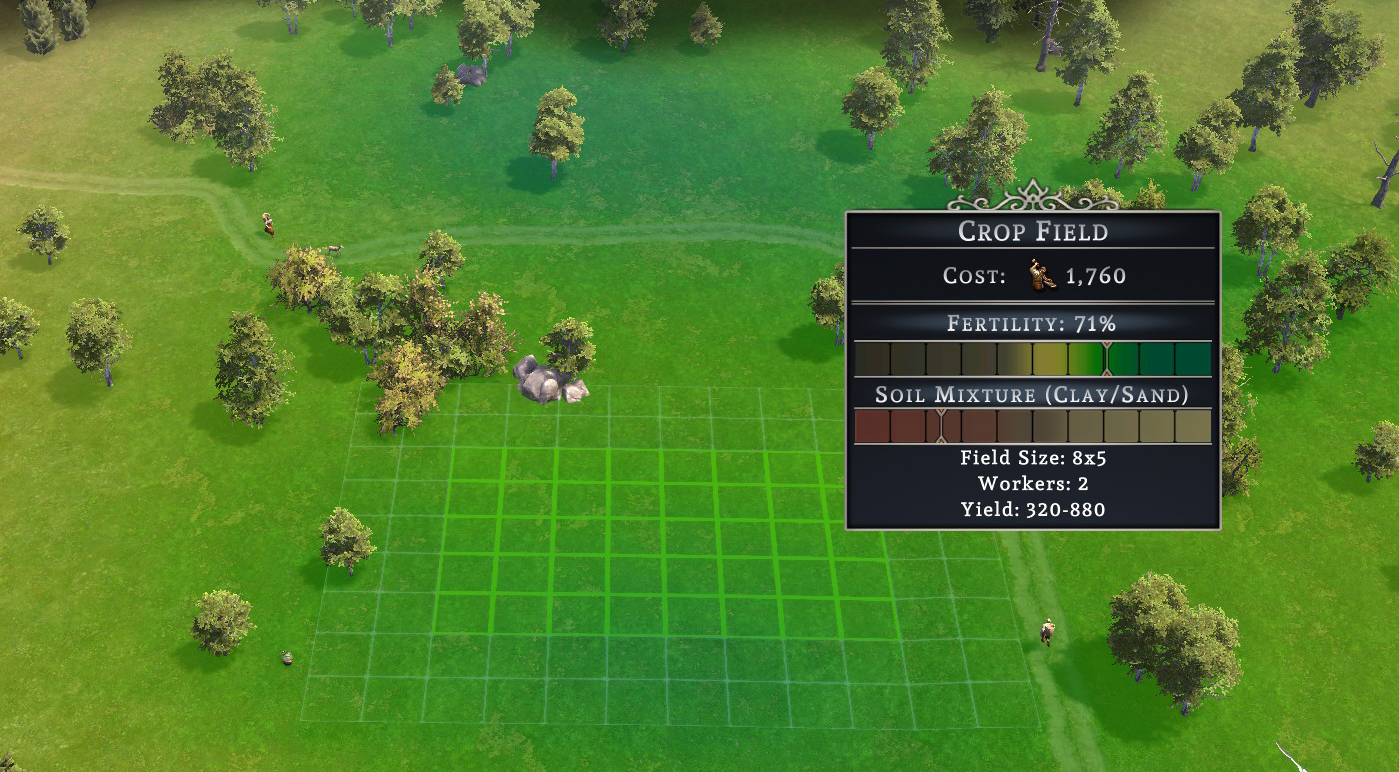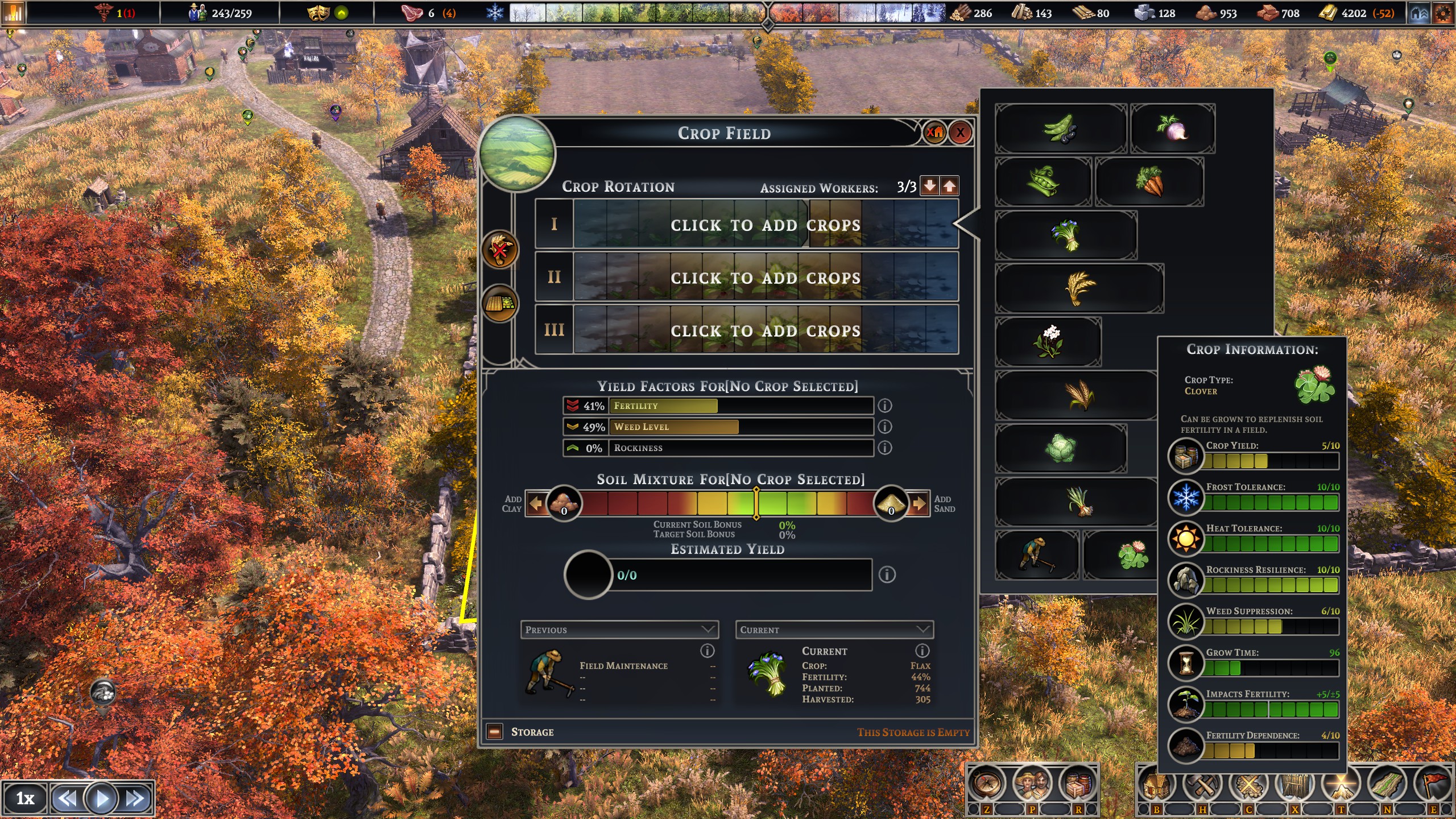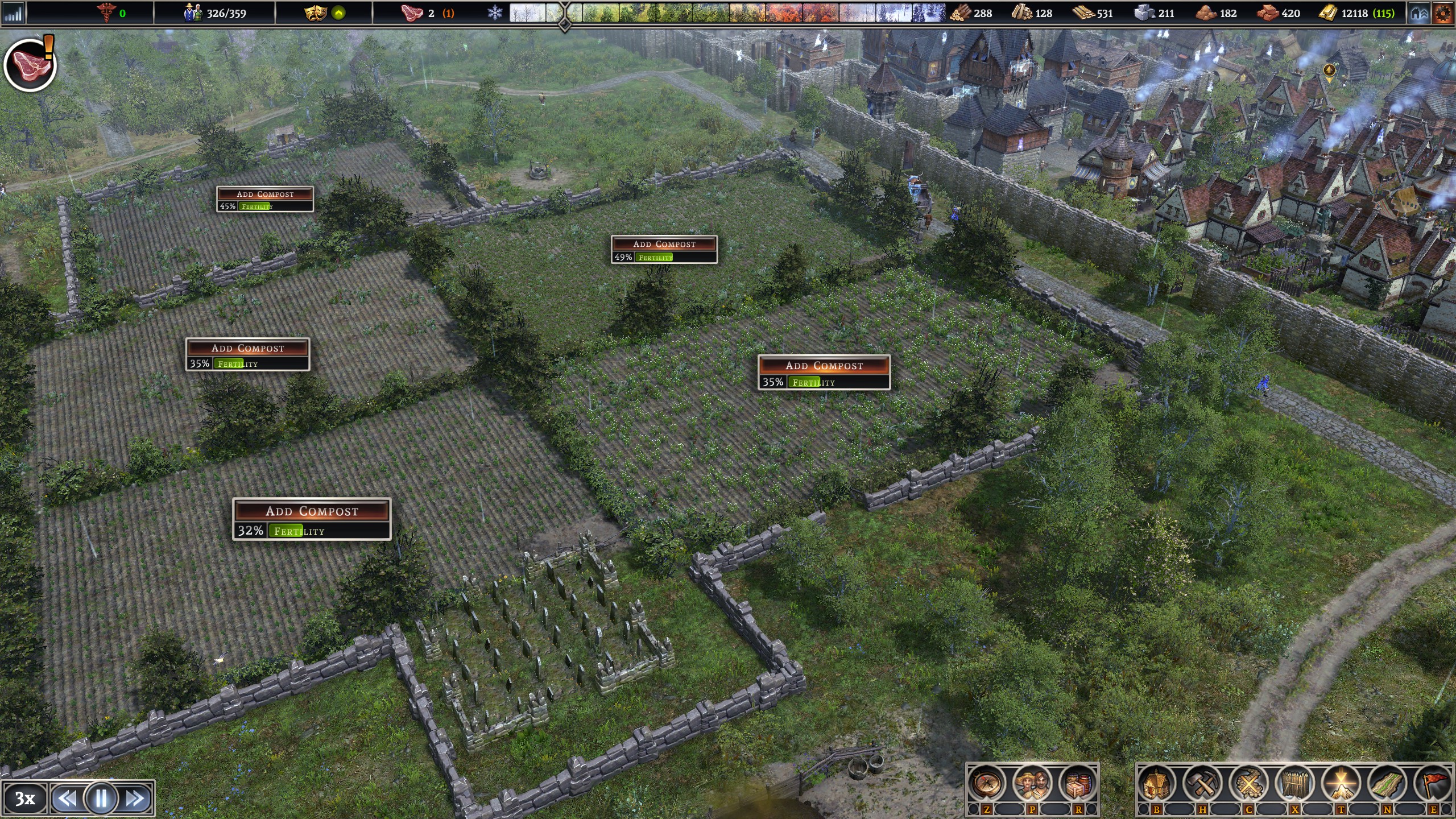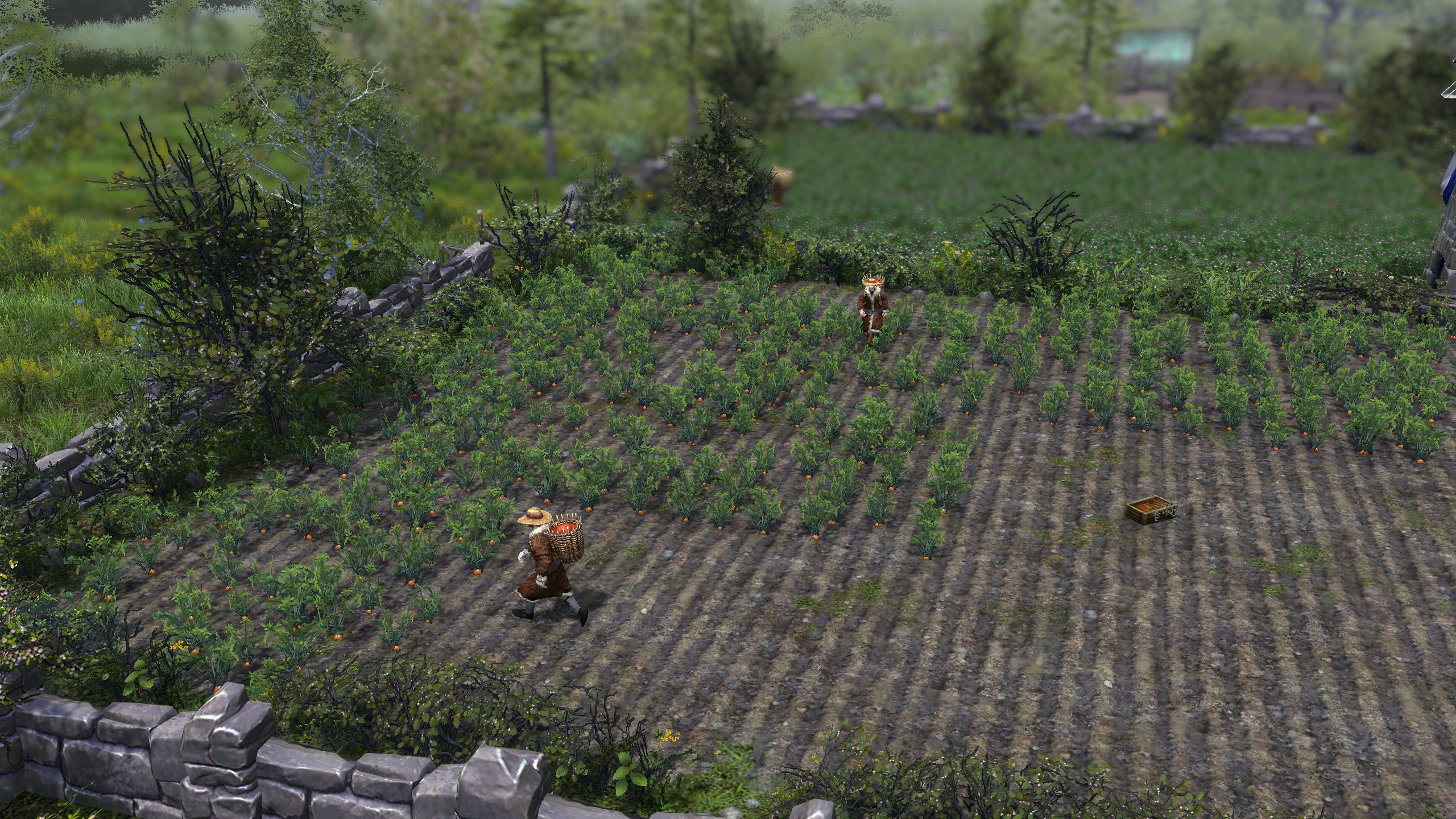Farthest Frontier crop rotation guide: Getting the most out of your farms
Crop rotation is one of the most complex systems in survival city builder Farthest Frontier. Here's how it works.

Farthest Frontier's crop rotation system is one of the survival city builder's most complex systems. Just like your villagers, crops are susceptible to summer heat waves, winter's freezing temperatures, and even diseases. Fields need to be free of weeds and rocks, and keeping the soil fertile to increase the yield of your crops can be a major challenge.
Villagers can hunt for meat, gather berries, and even plant fruit trees, but you'll need to do some real farming if you want your city to thrive. Growing grains means you can produce beer for your pubs and flour for baking, flax needs to be grown to create linen for clothing, and a crop of vegetables will give your villagers more food choices than just meat and fruit, which is important for making them happy. Rotating crops—not growing the same crop in the same field year after year—is necessary to prevent diseases and keep the soil healthy. Crop rotation is tricky, but it's also important to master.
Here's how Farthest Frontier's crop rotation system works, and how to make sure your crops are as healthy as possible.
Farm creation
How to create a farm
The farm creation tool is found in the food production tab, and it's easy to use: just click, hold, and drag the shape of your field. Fields need to be at least 5x5 in size, and can't be drawn larger than 12x12. However, you can enlarge and expand existing fields later from the farm menu.
As you're choosing the area for your field, the fertility overlay will be shown. Make sure you've got a nice fertility bonus before drawing your field—it'll appear greener than other areas. You'll also see a window filled with details: how many labor hours it will cost to clear and prepare the field, the soil fertility, the soil mixture, the minimum and maximum crop yield, and how many farmers it will require.
Once you've placed your field, you'll have to wait for the laborers to finish preparing it, which can take a long time—sometimes even years—depending on the size of your field, the state of the terrain, and how many laborers you have. Remember that in the winter months the work will come to a halt because the ground is frozen.
Crop Rotation
How crop rotation works
Once your field is ready you'll be notified you can plant your crops. No need to worry about seeds—your farmers have instant access to plant any crop they want. But the crop rotation window is a little complicated and not immediately intuitive.
Keep up to date with the most important stories and the best deals, as picked by the PC Gamer team.
You'll see three rows at the top, numbered I, II, and III. Row I is the current year, Row II represents next year, and Row III represents the year after that. You'll also see a slim vertical line somewhere in Row I: That represents the present date, the timeline of how far into the current year you are.
Below those rows you can see factors for your fields, such as fertility, weed level, and rockiness. You'll also see the soil mixture meter, which can be adjusted by adding clay on the left or sand on the right.
To add a crop, first click which year you'd like to grow it: Row I for this year, Row II for next year, or Row III for the third year. Then select your crop from the icons on the right. Hovering over a crop will give you each crop's statistics: yield (how much it will produce), frost tolerance, heat tolerance, rockiness resistance, weed suppression, grow time, how much it impacts soil fertility, and how dependent it is on soil fertility.
Clicking a crop will drop it into the year you've selected, and clicking the red X button to the left will remove it again. Once it's on your timeline, you can drag it left or right to change its position in the year. For a crop with a low frost tolerance, for example, make sure it's not too close to winter on either side of the timeline. For a crop with low heat tolerance, try not to plant it in the middle of the year when it's warmest.
You can also tell how long each crop takes to grow by how wide its icon is—this is how much space it takes up on your timeline. Wheat, rye, and leeks, for instance, take the longest to grow. So long, in fact, you can't grow them on the same field in the same year. So if you want to grow a second crop in the same field in the same year as wheat, you'd need to pick a crop with a shorter grow time, like turnips.
While you're choosing which crops to grow in each field, you should consider the soil mixture. You can change the soil mixture at any time by clicking "add clay" or "add sand" on either side of the soil mixture meter. With a crop on the timeline selected, the meter will display the optimal mix for that crop, and by adding clay or sand you can target the optimal mix for a 10% bonus. Most crops have different soil mixture bonus zones, so look for crops that have similar soil mixture needs by clicking on each crop and checking the meter.
Once you've set your crops up, the three-year cycle will repeat indefinitely until you make changes to them.
Soil Fertility
How to improve soil fertility
Fertility is the most complex factor for your crops, and there are a few different ways to improve it. Some crops heavily damage soil fertility, like wheat, rye, and flax, which also rely on soil fertility for a solid yield, so growing these crops on the same field year after year isn't going to produce much and will lower the soil fertility for your other crops as well.
To increase soil fertility, don't grow crops that negatively impact fertility too often in the same field. For instance, try growing wheat in year 1 on one field, in year 2 on a second field, and in year 3 on a third field. That way you'll have a wheat harvest every year but you'll only be growing it once every three years on a single field.
Having a compost yard can also aid soil fertility. If your village is growing, your citizens are generating compostable waste in their homes like spoiled food and, well, poop. If you haven't already built a compost yard and assigned some unfortunate villager as a nightsoil collector, do so immediately. I'd suggest building your compost yards near your farm, because when one of its compost bins are full you can click it and then choose which field you want to fertilize. Each field you have will show its fertility level, so pick the field that needs it the most. You can add compost to any field once per year.
Finally, you can grow clover on your fields. As a crop it's not going to feed anyone or produce sellable goods, but it'll greatly increase the fertility of the soil it grows in. If your soil fertility keeps dropping, plant a clover crop in place of another crop and see how it improves. Other crops that increase soil fertility (though not as much as clover) are beans and peas.
Rocks and weeds
Rockiness and weed level
The only way to lower a field's rockiness and weed level is by performing field maintenance. You can add a field maintenance period by clicking the farmer icon at the bottom of the list of crops, and during that period workers will tend the field to remove rocks and weeds. When you're first starting on a new field you'll probably need to do this a few times right away, but once the rockiness and weed level are lowered to zero, fields shouldn't require maintenance more than once every few years.
Wildlife protection
Fences, walls, and gates
Your villagers aren't the only ones who are hungry for fresh vegetables. Planting crops will attract wildlife like deer who can destroy a large portion of your yield. Once you've created a field, immediately build a fence around it, and make sure you add gates so your farmers can get in and out. When you have enough stone, you can upgrade the wooden fences into stone walls which will also help prevent raiders from smashing their way through your fences while they're attacking your village.
Harvest and storage
Harvest and storage
Another factor to consider is staggering the harvest time for each field. If you have multiple fields all requiring harvest at the same time, you may lose crops to rot simply because there aren't enough people to harvest your crops before they spoil. Storage should be taken into consideration, too: green leafy vegetables don't last as long in storage as other vegetables, so try not to have multiple fields producing only crops with short storage periods at the same time, or your villagers may go hungry.
The best crops
The best crops to grow
What should you plant in your first few fields? Here are all the crops ranked from best to worst for when you're starting out on your new farm, with notes about what strengths and weakness each have.
Turnips: A short growing time so you can have multiple harvests in the same year, and a good resistance to frost, heat, and disease. They're not exciting, but it's a sturdy and dependable crop.
Beans: Not a huge yield, but they last longer in storage than most crops and growing them improves soil fertility.
Peas: Excellent frost tolerance, but weak to heat so don't try to harvest them in the summer. They're great for improving soil fertility.
Buckwheat: Wheat is the most difficult crop, but buckwheat is a good alternative for grain production. It has a short grow time and can thrive in the heat. Also great at suppressing weeds in the soil.
Carrots: Frost resistant and they last a long time in storage, plus they don't need much soil fertility to grow. They don't do well on rocky fields, however.
Flax: Not a crop to rush into, but once you're ready to build a tailor shop you'll need flax to produce linen for clothing. Very sturdy crop, but will make the soil less fertile.
Clover: You can't eat it or sell it, but growing clover is one of the best ways to restore fertility to a field. Make sure it's somewhere in the rotation on your fields.
Leeks: Tricky because the grow period is extremely long, but they have excellent heat and frost resistance so they do well at all times of the year. Unfortunately, they spoil quickly in storage.
Cabbage: Frost and heat tolerant, but hard to grow well unless your soil fertility is high. Doesn't last long in storage, either.
Rye: Not as high yield as wheat, but doesn't need as much soil fertility. Does well in heat and in frost.
Wheat: The absolute worst, but a highly useful crop for flour and beer production. Will murder your soil fertility and is prone to disease, but stores pretty well as grain. Needs highly fertile soil for a decent yield.

Chris started playing PC games in the 1980s, started writing about them in the early 2000s, and (finally) started getting paid to write about them in the late 2000s. Following a few years as a regular freelancer, PC Gamer hired him in 2014, probably so he'd stop emailing them asking for more work. Chris has a love-hate relationship with survival games and an unhealthy fascination with the inner lives of NPCs. He's also a fan of offbeat simulation games, mods, and ignoring storylines in RPGs so he can make up his own.





